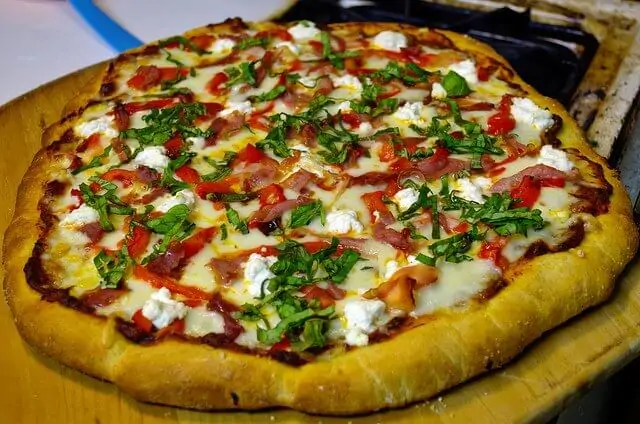
There’s simply nothing better tasting or more satisfying than making your own pizza in the comfort of your home. You don’t need a fancy firewood oven or Italian genes to make a crispy, mouthwatering pizza.
All you need is a pizza stone from Amazon.
Having some fresh ingredients and a big appetite is helpful as well. The best part about making pizza from scratch is you know exactly what the ingredients are and you are able to customize your pizza however you want.
Not just pizza
Most of us associate a pizza stone with making pizza — rightfully so. After all, pizza is in the name! However, there are many other uses for this versatile bakeware. Some common food items that you can make using a pizza stone are:
- Crackers
- Chips
- Cookies
- Different types of bread
- Pita
- Tortillas
- Scones
- Sweet or savory tarts
- Calzone
So what exactly is a pizza stone?
Simply put, a pizza stone is a baking dish that lets you add an extra crunch to your baked goods. It is flat, round and ranges from ½ to 1 inch in thickness. You may also come across square or rectangular pizza stones, which are more commonly used for making flatbreads.
This square stone from Amazon is the perfect back-up stone.
Natural materials
Since pizza stones are made of natural materials, such as stone or ceramic, they have the ability to absorb moisture extremely well. Another special quality of a pizza stone is that heat spreads evenly across the surface. As a result, the pizza crust bakes to perfection, becoming golden brown and delightfully crisp in no time.
Sometimes there’s just nothing like a good cookbook in the kitchen.
This one’s about pizza! (Amazon)
Glazed or unglazed?
When buying a pizza stone, you will notice that some are sold as “glazed” and others as “unglazed”. Although there isn’t much difference between the two, the glazed pizza stones are easier to clean. Deciding which one to get is based entirely on personal preferences, as both heat up and absorb moisture equally well.
If you’re wondering how a glazed stone can absorb moisture, it’s interesting to note that most glazed pizza stones have (intentional) tiny cracks that let moisture into the stone. Yet they still manage to be easy to clean. Like magic.
Check out the microscopic cracks on this Emile Henry! (Amazon)
Oh wait, you can’t see them.
How to use your pizza stone
Always allow your pizza stone to warm up with your oven. A pizza stone takes a long time to heat up and cool down. Once the oven is done preheating, the stone will still need a little longer to heat up. Another 30 minutes – 1 hour, depending on the thickness of your stone.
Most pizza calls for a very hot oven. 550ºF should do it.
Use a pizza peel
Some people like to make their pizza on the countertop then lift it with the peel to transfer it to the stone. I like to make the pizza right on the peel.
This pizza peel from Amazon is aluminum and easy-to-use.
After rolling out your dough on your prep surface, roll it over your pin and unroll it onto the peel. I like to put a good amount of cornmeal on the peel so before placing the dough so it won’t stick.

Make it your own
Add your sauce, toppings, cheese. Remember, with pizza, it’s all about restraint. Too much sauce leaves a doughy center. Too much cheese makes a chewy mess.
When your pizza is built just how you like it, bring the peel to the oven. With a few quick tugs of the peel, slide your pizza onto the stone.
Cooking time will vary depending on your dough and the thickness, but somewhere between 8 and 10 minutes should do it.
Eat!
Proper care
Whether it is your very first time using a pizza stone or you’ve had one for years, you should never cut corners when it comes to proper care and usage. Here are some tips to ensure your pizza stone lasts longer than your next pizza:
No soap flavored pizza!
Don’t use soap to clean your pizza stone. As with most natural materials, stone will quickly absorb the soap, quietly incorporating it into the flavor of your next pizza. If you want to impress your guests with your pizza making abilities, keep the soap far away from the stone!
As for germs, the high temperature of the oven will likely eliminate any potentially harmful bacteria.
Time for the season
Some people choose to “season” a brand-new pizza stone before use in order to prevent the dough from sticking to the surface.
To do this, use an oil of your choice and a small towel to cover the surface of your pizza stone with a thin and even layer of oil. Remove excess oil to prevent your stone from smoking in the oven.
Place your stone onto the lowest rack and heat the oven to 500º F. Bake the pizza stone for approximately 1 hour. Your stone will probably become darker or spotted after seasoning, which is completely normal.
Easy does it
Pizza stones are just like eggs. They do not handle drastic change well and are likely to crack if dropped. Make sure you ease them into temperature changes. Don’t put them in a hot oven when cold. Put them in the oven first, then head placed into direct heat.
Recipe alert! Here’s my no-yeast pizza dough.
Leave it in the oven
When your pizza is ready, it is best to remove the pizza and leave the pizza stone in the oven. This will allow the stone to cool down slowly.
If you do remove the pizza stone from the oven, always ensure to place it on a hot plate to avoid damaging your countertop, table or any other surface.
These silicone trivets from Amazon are great. And look super cool.
Allow your pizza stone to cool naturally. Don’t put it under water when it’s hot as this may cause it to break due to drastic change in temperature.
I picked the best pizza stone for charcoal grills. Check it out.
Stuck on you
Regardless of weather your pizza stone is seasoned or not, always be ready for a “sticky situation” to occur. Cheese and pizza sauce are some of the worst culprits when it comes to sticking to a hot pizza stone.
The best way to clean your pizza stone is by scraping the dirty areas with a spatula or a stiff bristle brush. Alternatively, you can place a damp cloth over the area you want to clean and leave it to soak. To prevent sticking in the future, sprinkle the pizza stone with cornmeal (Amazon).
Wrap up
Now that you know just how easy it is to use a pizza stone, it’s time to get creative and impress your next guest with a delightful baked treat!
Pizza stones aren’t the only way to make great pizza.
Here’s my recipe for cast iron pizza.
Additional Resources
Image credit via Flickr Creative Commons: russelstreet and Tom H.

![The Elements of Pizza: Unlocking the Secrets to World-Class Pies at Home [A Cookbook] The Elements of Pizza: Unlocking the Secrets to World-Class Pies at Home [A Cookbook]](https://m.media-amazon.com/images/I/51iKeUfMWIL.jpg)







Alexis DeAnda is a food fanatic, library card user, and cast iron hunter, in that order. She has been cooking for anyone that will taste it ever since her mom let her make doughnuts on Saturday mornings at the age of 7.